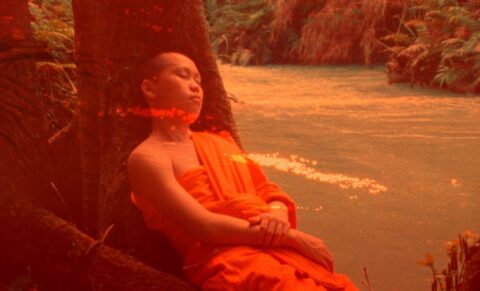Spoilers for Samsara (Lois Patiño, 2023) follow. It’s certainly recommended to watch this unique film first without knowing anything else about it.
—
Can you watch a movie with your eyes closed? With Samsara it appears that you might be able to. Around halfway through the film, after the death of an old lady in Laos, she begins her journey through the bardo — not the protagonist of Inarritu’s eponymous 2022 movie, but a liminal state between life and death.
Here Patiño, supremely confident after about an hour of careful enthography, pulls one of my favourite cinematic tricks. Like Alexandre Koberidze in What Do We See When We Look at the Sky (2021) playfully writing, “Dear Audience, please close your eyes at the first signal” or Bi Gan solemnly instructing participants to put their 3D glasses on halfway through Long Day’s Journey into Night (2018), he tells the audience exactly how they should watch his film.
In this instance, a polite title card tells us not to watch his film during its most transcendent sequence; a 15-minute flurry of flashing lights scored to experimental droning music and traditional gongs and bells, as well as sound design varying from busy insects to the sound of an accordion. The lady’s spirit is floating through space, and so is the audience; overwhelmed and transfixed. I’ve never seen (or never not seen) anything quite like this before.
The reason you don’t have to physically look at the screen (other than your own protection; photosensitive viewers beware!) is that despite your eyes being closed, the flashing images pierce through your eyelids, allowing you to see without actually seeing. At once terrifying and liberatory, the flashing effect created a kind of tunnel effect in my mind-vision, like watching 2001: A Space Odyssey (Stanley Kubrick, 1968) in my dreams. You should watch it on the biggest screen possible (I watched it at home.)
As a correlative to the idea of rebirth — the central thesis of the movie, excellently covered by my contributor Daniel Turner — it works perfectly, making me ponder what it might be like to die and be reborn according to Buddhist tradition. (And certainly much more interesting than seeing yet another person’s life flash by in a series of stereotypical sequences.)
And, often, not seeing is far more profound than actually seeing. I think of Blue (Derek Jarman, 1993), with its simple blue screen accompanied by narration and sound effects; or falling asleep during Memoria (Apichatpong Weerasethakul, 2021) and feeling all the richer for it. After all, like when reading a book, nothing is more powerful than the images conjured up — with all their dreadful and/or wonderful associations — in your own head.
And while I certainly wouldn’t encourage a proliferation of gimmickry (4DX; wine pairings; the return of silent cinema), in the future, these innovations certainly show the benefits of being bold, using experimental ideas and thinking outside the box in terms of cinematic presentation. Within (and without) the frame lies a world of possibility.
Redmond is the editor-in-chief of Journey Into Cinema.

